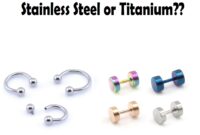
Body piercing has been practiced since ancient times as a way to adorn the body with decorative ornaments like rings, studs, and fittings. Among the enduring traditions that continue to captivate people today are ear, nose, and belly ring piercings. In this article, we’ll focus on nose piercing and delve into the variety of rings and studs available for this type of piercing.
Nose piercing traces its roots back to traditional African and Asian cultures, where it held symbolic significance related to beauty, status, and wealth. In modern times, nose piercing has gained popularity as a hip and trendy fashion statement, embraced by both young men and women.
Different Types of Nose Piercings
Nose piercings come in various types based on the specific area that is pierced. The most common and widely practiced is the nostril piercing. It involves piercing the nostril just above the crease where the nose meets the cheek. This location offers accessibility for a wide range of jewelry options, including L-shaped studs, nose rings, ball rings, and nose screws, among others.
Another popular type is septum piercing, which has gained widespread popularity, even among men. It involves piercing through the nasal septum without going through the cartilage separating the nostrils. Circular barbells or loops are commonly used for this type of piercing. There are also other less common types, such as nose tip piercing and bridge piercing, which are becoming increasingly popular as people explore different ways to adorn their noses.
The Nose Piercing Procedure
Nose piercing is a delicate procedure that should be performed by a knowledgeable professional. Hygiene is crucial to prevent infections and promote healing. The following outlines a brief protocol for the common nostril piercing:
1. Choosing the Location: The first step is selecting the desired location for the piercing. Both nostrils can be pierced simultaneously, but factors like cultural significance and personal preferences may influence the decision.
2. Marking the Location: The piercer marks the chosen location and confirms your approval before proceeding.
3. Aseptic Piercing: The piercing is performed using sterile equipment and techniques to ensure cleanliness and minimize the risk of infection.
4. Fitting the Jewelry: After the piercing, a steel nose screw with a size typically around 20G is inserted. The piercer will provide instructions on how to care for the piercing until it heals.
5. Healing and Adornment: With proper aftercare, the piercing will heal relatively quickly, allowing you to experiment with different types of nose studs or rings to suit your style and preference.
In Conclusion
Nose piercing has become a popular trend due to its fashionable appeal while maintaining a somewhat discreet appearance. Whether you opt for a nostril piercing, septum piercing, or other variations, it’s important to choose a reputable piercer, prioritize hygiene, and follow aftercare instructions to ensure a safe and successful piercing experience. Embrace the art of nose piercing as a unique and stylish form of self-expression.


